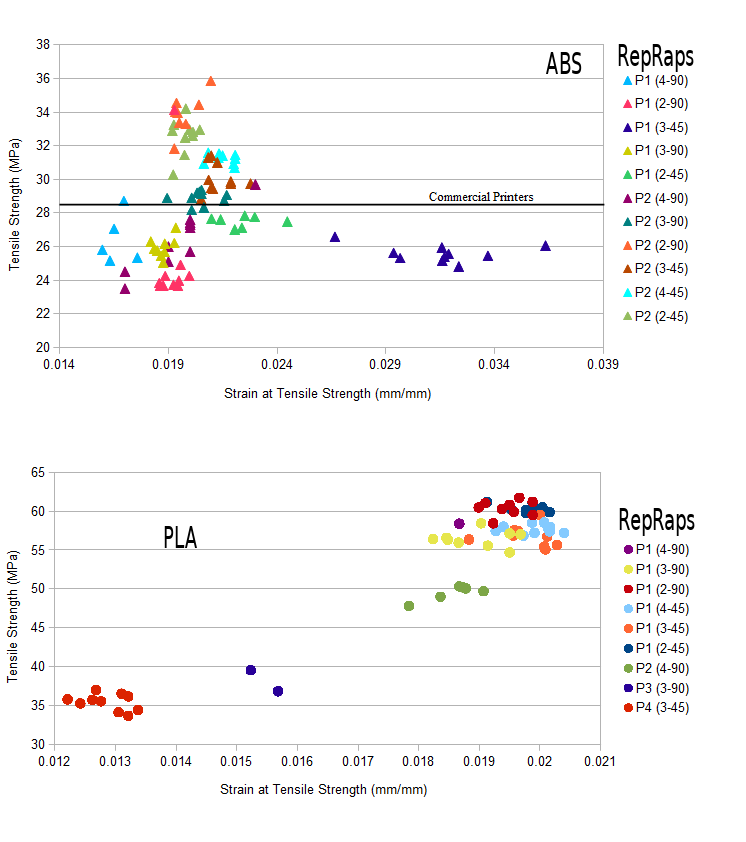The recent development of the RepRap, an open-source self-replicating rapid prototyper, has made 3-D polymer-based printers readily available to the public at low costs (<$500). The resultant uptake of 3-D printing technology enables for the first time mass-scale distributed digital manufacturing. RepRap variants currently fabricate objects primarily from acrylonitrile butadiene styrene (ABS) and polylactic acid (PLA), which have melting temperatures low enough to use in melt extrusion outside of a dedicated facility, while high enough for prints to retain their shape at average use temperatures. In order for RepRap printed parts to be useful for engineering applications the mechanical properties of printed parts must be known. This study quantifies the basic tensile strength and elastic modulus of printed components using realistic environmental conditions for standard users of a selection of open-source 3-D printers. The results find average tensile strengths of 28.5 MPa for ABS and 56.6 MPa for PLA with average elastic moduli of 1807 MPa for ABS and 3368 MPa for PLA. It is clear from these results that parts printed from tuned, low-cost, open-source RepRap 3-D printers can be considered as mechanically functional in tensile applications as those from commercial vendors.
Highlights[edit | edit source]
- Open-source self-replicating rapid prototyper, RepRaps are 3-D printers.
- Low costs enable mass-scale distributed digital manufacturing in ABS, PLA.
- Average tensile strengths of 28.5 MPa for ABS and 56.6 MPa for PLA.
- Average elastic moduli of 1807 MPA for ABS and 3368 MPa for PLA.
- RepRaps are as mechanically functional as commercial 3-D printers
Major Findings[edit | edit source]
Using tensile specimen here:http://www.thingiverse.com/thing:28987
See also[edit | edit source]
- Tensile Strength of Commercial Polymer Materials for Fused Filament Fabrication 3-D Printing
- Anisotropic mechanical property variance between ASTM D638-14 type I and type IV fused filament fabricated specimens
- Fused Particle Fabrication 3-D Printing: Recycled Materials' Optimization and Mechanical Properties
- The Effects of PLA Color on Material Properties of 3-D Printed Components
- Mechanical properties of 3-D printed truss-like lattice biopolymer non-stochastic structures for sandwich panels with natural fibre composite skins
- Open source rapid prototyping of OSAT
- RepRap Mechanical Testing Literature Review
- Tensile test protocol: MOST
- Wood Furniture Waste-Based Recycled 3-D Printing Filament
- Viability of Distributed Manufacturing of Bicycle Components with 3-D Printing: CEN Standardized Polylactic Acid Pedal Testing
- Environmental life cycle analysis of distributed 3-D printing and conventional manufacturing of polymer products
- Recyclebot
- RepRapable Recyclebot: Open source 3-D printable extruder for converting plastic to 3-D printing filament
- Life cycle analysis of distributed recycling of post-consumer high density polyethylene for 3-D printing filament
- Recyclebot on RepRap wiki
- Mechanical testing of polymer components made with the RepRap 3-D printer
- Development and feasibility of applications for the RepRap 3-D printer
- Life cycle analysis of distributed polymer recycling
- Solar powered distributed customized manufacturing
- MOST RepRap Build
- Life cycle analysis of distributed polymer recycling
- What is the influence of infill %, layer height and infill pattern on my 3D prints?
- A few ways to strengthen 3D printed parts - STEP 3D (really nice summary of methods to strengthen parts)
- [PDF Impact of Process Parameters on Tensile Strength of FDM Printed Crisscross PLA]
- Improving the Impact Strength and Heat Resistance of 3D Printed Models: Structure, Property, and Processing Correlationships during Fused Deposition Modeling (FDM) of Poly(Lactic Acid) - showed increased impact resistance with print bed temp high, more crystalline - post print anneal
- Improved model and experimental validation of deformation in fused filament fabrication of polylactic acid
- Chemical Compatibility of Fused Filament Fabrication-based 3-D Printed Components with Solutions Commonly Used in Semiconductor Wet Processing
- Compatibility of 3-D printed devices in cleanroom environments for semiconductor processing
- 3-D Printable Polymer Pelletizer Chopper for Fused Granular Fabrication-Based Additive Manufacturing
- Mechanical Properties of Ultraviolet-Assisted Paste Extrusion and Postextrusion Ultraviolet-Curing of Three-Dimensional Printed Biocomposites
- Vacuum Outgassing Characteristics of Unpigmented 3-D Printed Polymers Coated with ALD Alumina
- 3-D printed magnetic soft magnetic helical coil actuators of iron oxide embedded polydimethylsiloxane
- Thermal Post-Processing of 3-D Printed Polypropylene Parts for Vacuum Systems
- Understanding the multilevel phenomena that enables inorganic atomic layer deposition to provide barrier coatings for highly-porous 3-D printed plastic in vacuums
Media[edit | edit source]
- Open-source 3D printed parts often stronger than proprietary versions -3Ders
- Michigan Tech Study Suggests Some RepRap 3D Prints Are As Strong as Commercial 3D Printers- 3D Printing Industry
- Some RepRap 3D Prints Are As Strong As Industrial And Commercial 3D Printers - 3D Printer Plans
- Measuring Open Source Hardware 3D-Printed Material Strength- EE Times
- Desktop 3D Printed Parts Can Be as Tough as Industrial and St3p3D Shows You How - 3D Printing and Industry
- A few ways to strengthen 3D printed parts - St3P3D and 3Ders






